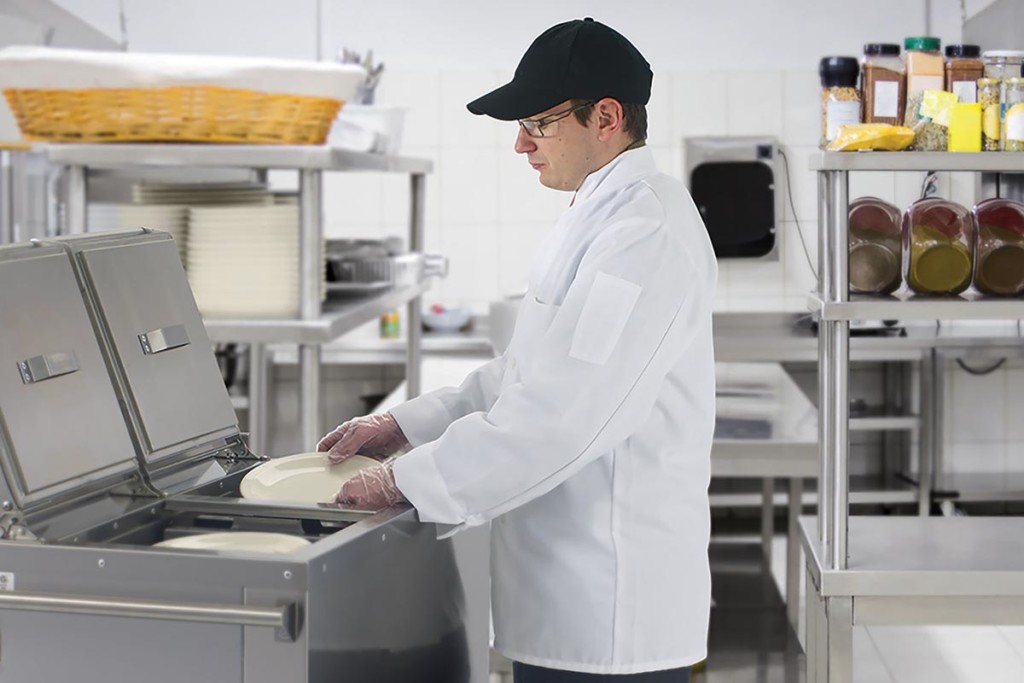
Plate dispensers are relatively basic pieces of equipment that serve a big role in healthcare foodservice operations. They keep plates organized and at the ready anywhere from the patient meal-tray assembly line to a front-of-house serving station. Despite their fairly uncomplicated nature, though, you should be aware of the differences and options available for specifying the right model for your facility’s needs.
Makers offer mobile plate dispensers and drop-in dispensers, which are permanently fixed in a counter. Mobile plate dispensers, the focus of this article, enable employees to load plates directly from the dishwashing area and move the dispenser where it’s needed. They also work well at kiosks and special events.
Working in Silos
All mobile plate dispensers stack and store clean plates in silos within stainless cabinets on casters. Units typically stand approximately 40-in.H and offer from one to four silos, each silo holding between 50 and 75 plates, depending on the model and type of plate.
How many dispensers do you need? One manufacturer recommends matching quantity to the number of meals served. For example, if a facility serves 450 meals at peak dining periods, two units—each with three 75-plate silos—fit the bill. Depending on where the plates are needed, you might instead choose a different combination of single-, two-, three- and four-silo dispensers.
Dishes are stacked in the silo, with spring-loaded lowerators keeping the top plate at the top of the silo regardless of how many plates are in the unit. Silos come in various sizes to accommodate a range of plate diameters. While plate diameters from 8 in. to 12 in. are most common, manufacturers make units with silos that can handle plates as small as 3 in. in diameter.
Plate silos are adjustable, to an extent. A dispenser with a silo built for 10-in. to 12-in. plates can easily handle dishes within that diameter range, but is not built for 6-in. plates. Inserting non-marring rods into the silo allows additional flexibility for smaller diameter plates, but the better bet is using a dispenser specifically designed for smaller plates. Smaller diameter plates placed in wider silos can move around increasing the chances of chipping or breakage.
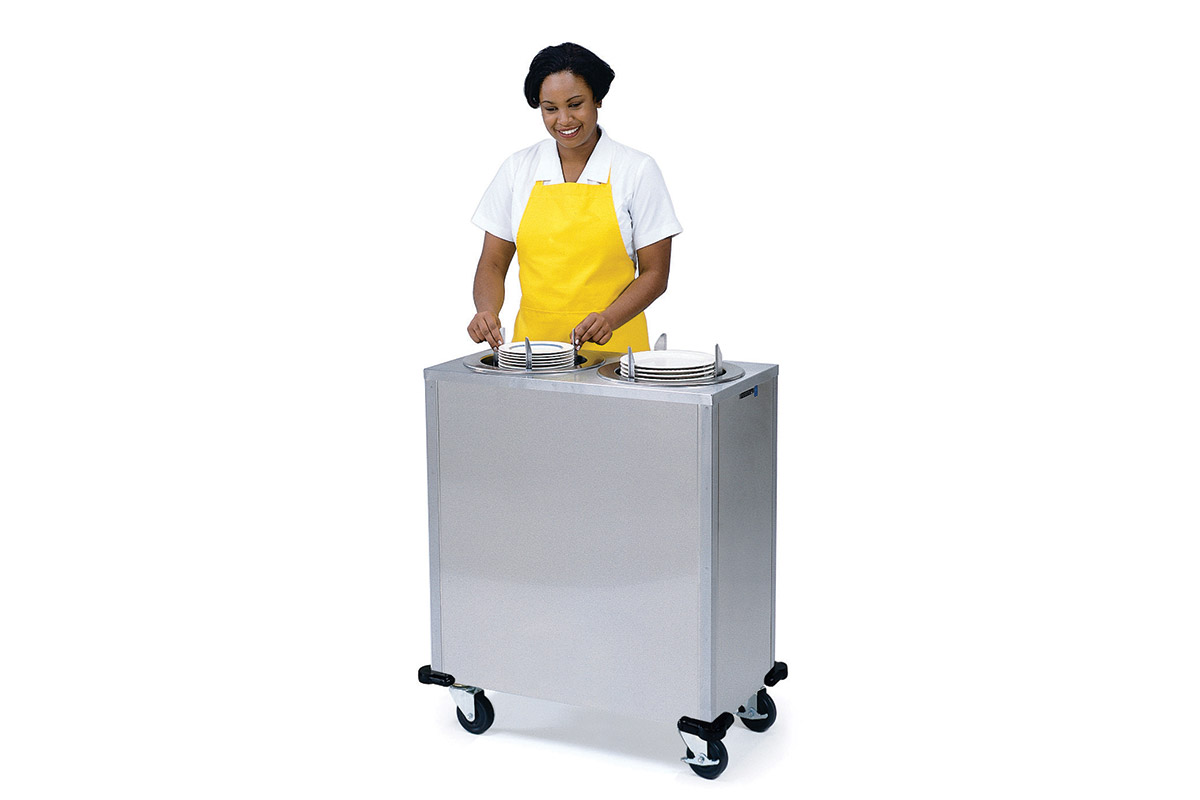
Silos can accommodate a range of plate diameters. Most units fi t 8-in. to 12-in. plates but some handle dishes 3 in. in diameter. — Courtesy of Lakeside.
Unheated or Heated
Plate dispensers come in unheated and heated models. Unheated dispensers are the smart choice—temperature-wise—for plating areas serving cold food or a combination of cold and hot food, such as buffets, salad bars and sandwich stations.
But for plated hot meals, heated plate dispensers work best. Hot food served on ambient temperature plates cools faster than when served on heated plates. Additionally, covering hot food on an unheated plate leads to condensation on the inside of the cover as moisture is pulled out of the hot food.
Heated dispensers keep plates warm with either radiant or convection heat. Depending on the maker and model, temperatures typically range from 100°F-180°F. While some basic models offer only one temperature, others have a variety of presets or come with manually adjustable thermostats. Higher-end convection models may have digital temperature readouts.
Radiant models use a heating element at the bottom of the silo. The rising heat warms the plates. Lids help keep heat from escaping but plates will be cooler, even with the lid closed, at the top of the silo. Radiant heat models are cheaper to maintain than convection units because there are fewer moving parts.
In convection units, a fan near the heating element moves hot air throughout the silo cavity, distributing more uniform heat to all of the plates throughout the stack.
Radiant heaters can take three to four hours to get a full load of room temperature plates to 120°F while some convection units take less than two hours to bring plates to 170°F. Plates loaded straight from the dishwasher into either style of dispenser before they cool take much less time to bring to temperature.
The electrical capacity of heated dispensers varies by maker and model. Some units are 120V, some 208V and others 220V. Heating elements vary as well and include 400W, 450W, 500W and 700W offerings. You’ll need to match the unit with your facility’s service.
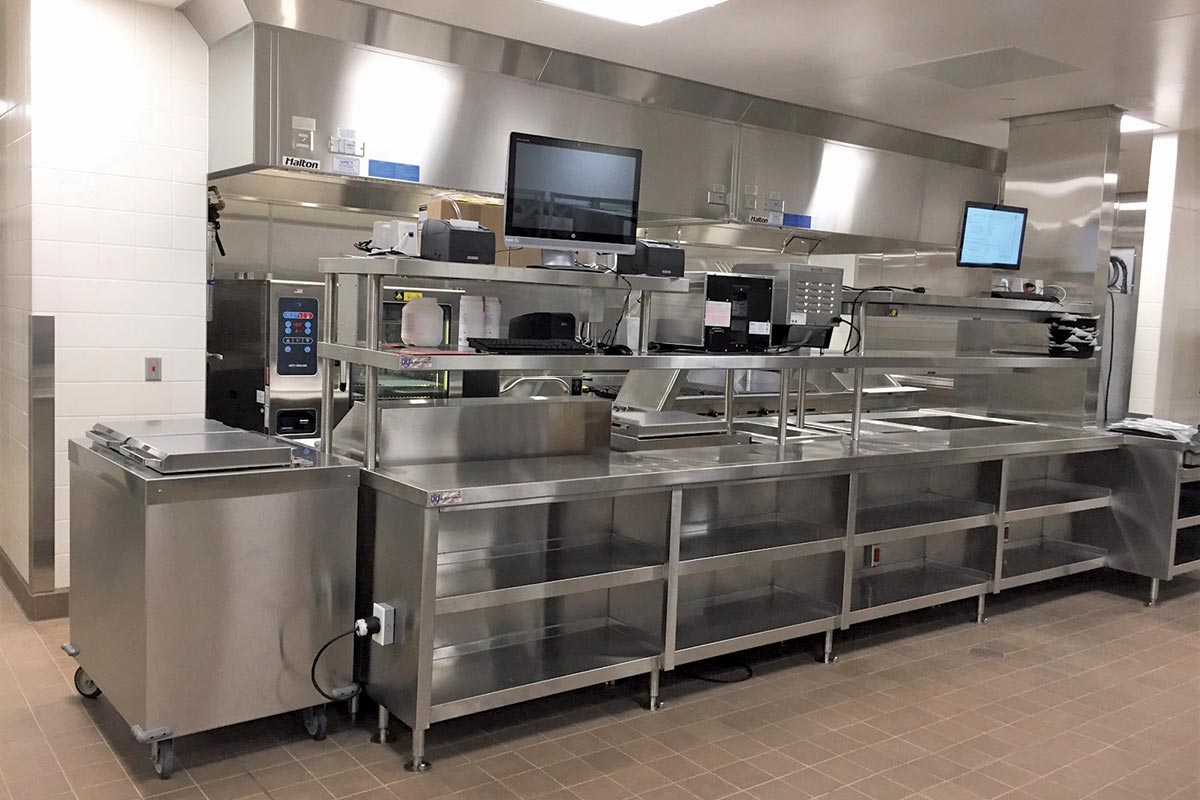
Casters allow employees to load plate dispensers in the dishroom and then transfer them to the assembly line. Lids help retain heat. — Courtesy of Webb Foodservice Design.
Field Adjustments
Dispensing silos are spring-loaded and can be easily adjusted by operators. Springs set too tightly raise top plates above the opening, letting ambient air cool them. Lids, if used, should close properly and not let air in; upward pressure from dishes in a silo with overtightened springs can push lids up, reducing their efficiency.
On the flip side, slamming stacks of plates into dispenser silos puts stress on springs and requires adjustments more often. When springs are too loose, plates won’t reach the top of the silo.
To adjust, remove plates from the dispenser tube and pull the tube out. Springs are located around the tube in equal numbers. Worn springs are easy to unhook and replace. When springs are set too tightly, unhook one spring per section to start; you may remove additional springs as needed, just make sure you end up with the same amount of working springs in each section so the weight of the plates is handled evenly for a level stack. When unhooking springs, leave one end hooked so that unused springs remain in place for future use.
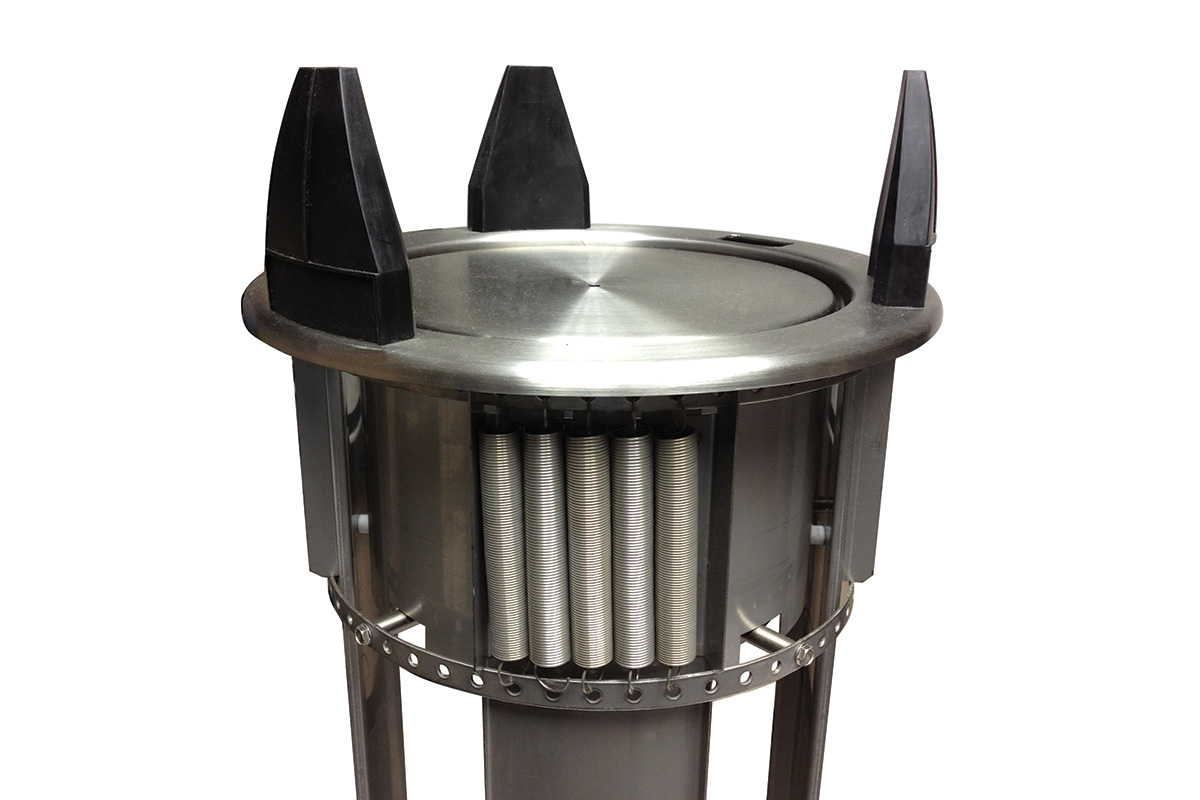
Adjust the tension of the carriage for different types of dinnerware. Lift the tube out and connect or disconnect tension springs. — Courtesy of Carter-Hoffmann.
Simple Cleaning
Plate dispensers require little maintenance. Clean the outside surfaces daily with soap and water. Stainless cleaner works well for fingerprints and other stains.
Remove the dispensing tubes periodically and wipe down. This is a perfect time to look for worn springs, too. With the tubes removed, inspect the bottom of the silo for any debris or spilled food (which should be minimal if plates are added straight from the dishwasher).
Defer to a qualified service technician when replacing heating elements and/or fans.
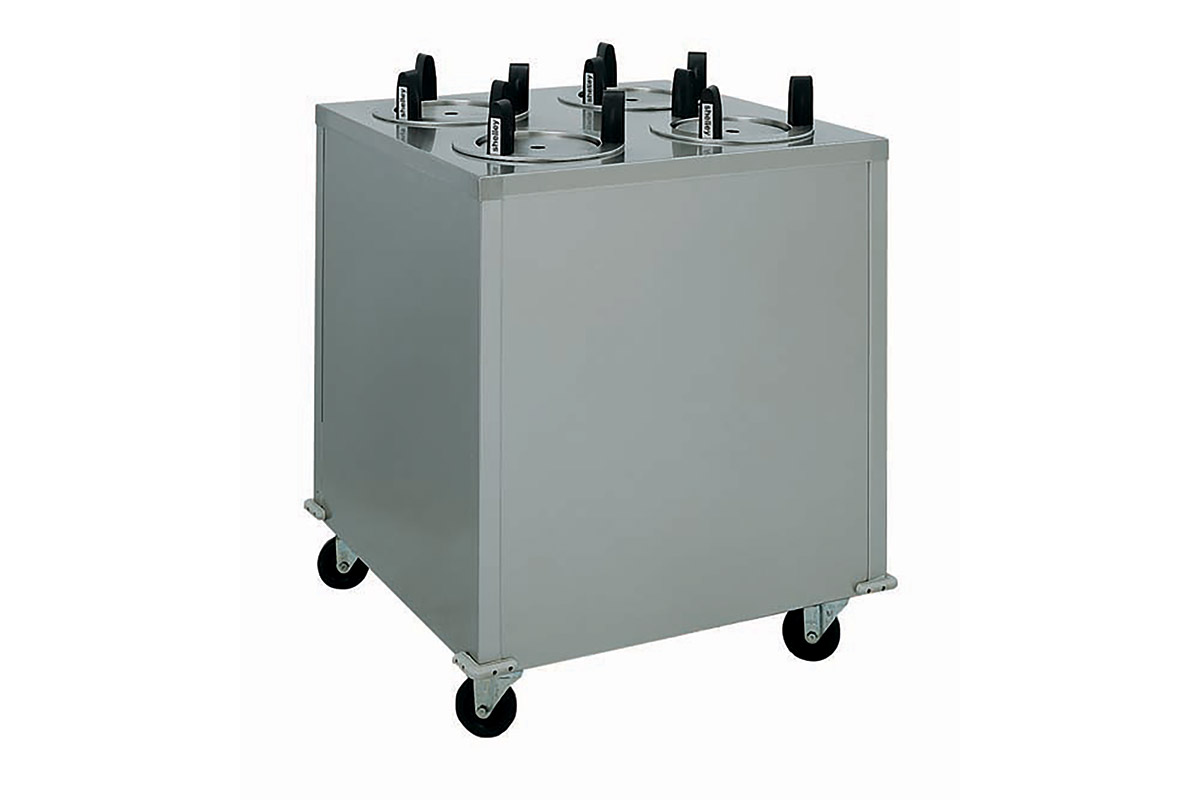
Note construction features. This dispenser uses 16-gauge stainless on top and 20-gauge stainless on sides. Bumpers limit markings. — Courtesy of Delfield.
Special Features
One enhancement to consider includes a latch on the dispenser’s lid, allowing employees to lock it in an open position. The convection heat still flows, but having the lid locked in the open position when loading and unloading keeps employees from frequently opening and closing the lids, reducing the possibility of slamming fingers and hands.
Many mobile units come with corner bumpers to prevent damage to walls and other equipment while moving; some manufacturers offer optional wraparound bumpers for additional protection.
Top Takeaways
- Mobile plate dispensers add flexibility to the front- and back-of-house as well as catered and off-site events.
- Use heated plate dispensers for plating hot food.
- Unheated plates are best for cold food serving areas or those serving a combination of hot and cold foods.
- Silos handle some variation in plate diameter and are somewhat adjustable, but be sure to specify a model designed to handle your typical plate size.
- Dispensers using convection rather than radiant heat to warm plates are more expensive to maintain but provide more consistent plate temps throughout the silo
- Convection models also bring plates to temp faster than radiant units.
- Springs adjust easily, preventing over- or under-tightening.
- Plate dispensers, whether heated or unheated, require little maintenance apart from daily exterior cleaning.
- Advertisement -
- Advertisement -
TRENDING NOW
- Advertisement -
- Advertisement -
- Advertisement -
